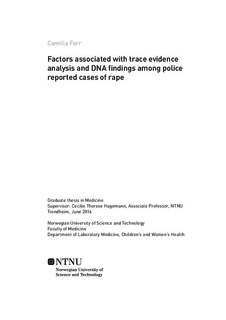| dc.description.abstract | Background: The medical examination after rapes has two main goals: to provide high-quality care for the victim and to collect evidence to be used in the crime investigation. Collected samples are sent for forensic analysis upon police request. However, little is known about how the police select cases to be submitted for analysis. Furthermore, few studies report the DNA findings and associated factors. The aim of this study was to examine whether victim-, suspect- and assault characteristics, were associated with (1) forensic analysis of trace evidence, (2) detection of spermatozoa and (3) DNA match in police-reported cases of rape/attempted rape. In addition, we explored whether DNA findings were associated with police investigations and legal outcome. Methods: We conducted a retrospective, descriptive study based on police-reported rapes and attempted rapes of female victims (≥ 16 years of age) in Sør-Trøndelag Police District throughout 1997 – 2010. Police data were merged with information from the Sexual Assault Centre (SAC) at St.Olavs University Hospital, Trondheim, Norway. Altogether 324 cases were included. We applied Pearson’s x2 tests for the analyses. Statistical significance was assumed when p < 0.05. Results: Among 324 victims (mean age 24.2 ± SD 8.4 years), swabs and/or clothes were collected from the victim in 299 cases, of which 135 were sent for forensic analysis. The police decision to analyze the forensic material was associated with a public venue (p = 0.006) and interval from assault to sampling < 24 h (p = 0.033). Trace evidence analyses could be evaluated in 129 of the cases, and were positive for spermatozoa in 79 cases. Among samples collected within 24 h, 90 % were positive for spermatozoa (p = 0.003). In addition, detection of spermatozoa was associated with a reported penetrative rape (p = 0.006). The police requested forensic analyses of available trace evidence collected from the victim and/or the suspect (swabs and/or clothes) and/or the venue in 143 cases. The forensic analyses disclosed matching DNA profiles in 57 cases (40 %) and no matching DNA profiles in 50 cases (35 %), whereas 36 cases (25 %) were classified as “other”. DNA match was associated with absence of victim vulnerability factors (p = 0.001), victim being known to the suspect (p = 0.013) and a private venue of the assault (p = 0.013). In addition, interrogation of the suspect (p < 0.001), crime scene examination (p = 0.013) and the suspect admitting sexual contact (p = 0.003), were associated with a DNA match. A higher proportion of cases with DNA match were prosecuted in court (p < 0.001). Discussion: The police requests more analyses and detects spermatozoa in 90 % of the cases when the interval from assault to sampling is < 24 h. Spermatozoa is an evidence that gains further importance with the increased availability and progressive advances in DNA-profiling techniques. When there was a DNA match between the victim and the suspect, a higher proportion of the cases was taken to court. Nevertheless, DNA evidence should always be considered in the scope of other evidence. Conclusions: Our study provides descriptive data regarding trace evidence analyses and DNA findings and identifies potential factors that influence the analyses and DNA findings. These results may improve the quality of medico-legal care. | nb_NO |
